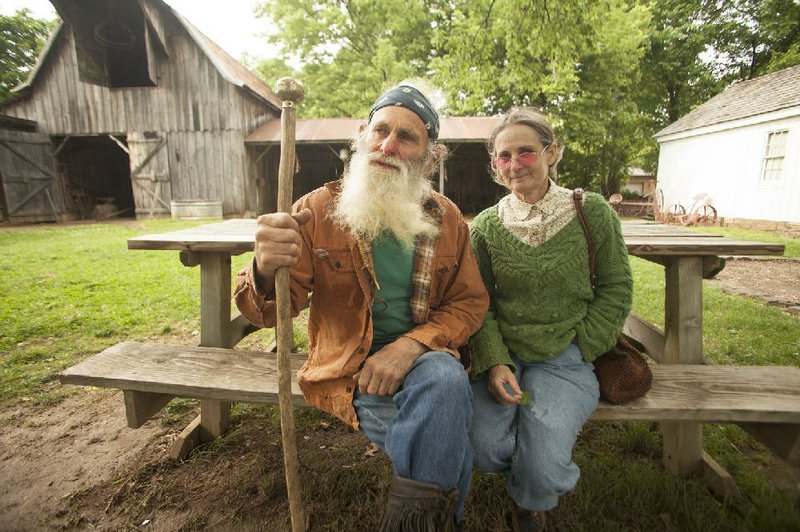SPRINGDALE -- Robert Runyan is not the only person to keep vivid memories of childhood cartoons in his head for decades, but he's probably one of the few whose life's work grew from what he saw in the backgrounds of them.
"I've always had a keen interest in log structures and primitive building techniques," Runyan said. "I was always drawn to that aspect. I remember being a kid, watching Snow White and the Seven Dwarfs, and being enthralled with the log work and the stone work in the background."
Runyan, 65, went on to construct some of the most noted hand-built log and stone structures throughout the region using techniques that predate not only the settling of the Ozarks but also the founding of the nation.
On Thursday, the Arkansas Arts Council honored Runyan as the recipient of the 2014 Living Treasure award. The council recognized him for the numerous structures he and a small group of like-minded craftsmen have built throughout Arkansas, Oklahoma and Colorado over the past four decades.
The council, which has named a state "living treasure" each year for more than a decade, enlists an independent panel of artists and folk-art experts to evaluate nominees for the award based on criteria including the quality of work, the artist's social effect on Arkansas and the effect of the artist's work on his craft.
Runyan, who lives in Winslow, first learned to build rudimentary structures with basic hand tools in the Boy Scouts while growing up in Jackson County. After leaving college several hours short of completing a degree in pre-medicine from Arkansas State University in 1970, Runyan and several friends traveled to Colorado "on a lark."
"I just got tired of school," Runyan said. "My whole life had been outdoors, and I just went back outdoors."
Runyan said he and his friends discovered a dilapidated cabin on private ranch land. With permission from the owners, Runyan and his friends scavenged building materials from their jobs as construction laborers and tried to refurbish the cabin piecemeal, with no real design or plan.
"It was just utilitarian," Runyan said. "We were learning on the fly. We lived there a year, and when I came back is when I got my first formal job. It was the first time I got to build one from the ground up."
Runyan built a house for his first client in a rural area near Tulsa in 1972. From the outset, Runyan's trademarks were painstaking selection of materials, including the selective cutting and use of timber and stone from the site, and techniques such as hand-shaping the logs so that cabin walls fit tightly without use of nails or tongue-and-groove routing.
Runyan is also known for using the same sort of hand tools that would've been found on home-building sites 150 years ago.
"I try to use as many hand tools as I possibly can," Runyan said. "At times, I'll use a chain saw and drills and stuff like that, just to expedite things -- time sometimes becomes of the essence. I just like working with my hands, real tactile stuff."
Runyan has also been known to use teams of mules to pull sleds full of building materials across construction sites, and even to pull large sections of roofs into place with ropes and pulleys.
The typical construction time for one of his log cabin homes, which range in size from 1,200 to 2,400 square feet, is about two years, Runyan said.
"When you do one of these buildings, you're not just ordering modular, dimensional material," Runyan said. "So you've got to get all your material you think you're gonna need, plus a little more, on-site before you ever start.
"If you're the client, you've got to have a lot of patience and be really dedicated to what's happening, or you'll get burnt out."
Despite the slow pace of building his homes, Runyan said he's never had a real falling-out with a client.
"We try to stay as adaptable as possible," Runyan said. "I've had to sit down and discuss things with people -- why you shouldn't do this, or why you should do that, in order to ensure things come out in the end as they want."
During his career, Runyan has built notable structures including the pavilion near the Yellow Rock Trail at Devil's Den State Park, built from original Works Progress Administration blueprints after the original structure burned down, and he helped restore the historic Rice-Upshaw House in Pocahontas.
Joy Pennington, executive director for the council, said Runyan is the embodiment of traditional folk craft.
"He's self-taught," Pennington said. "And of course, the quality of his work is just outstanding. That's one of the things we look for in an Arkansas Living Treasure, is someone who has elevated their craft to an art form, and he truly has."
Runyan takes pains to explain that his body of work was really the product of the small group of similarly talented craftsmen with which he has worked most of his career.
"It's not just about me, it's about a lot of people," Runyan said. "Patrons and peers. The people who had the foresight and finances to let the project happen, and all my workmates."
"We've always approached these projects as a guild," Runyan said. "Nobody's really the boss. We've all got our strong points, we've all got our weak points. So we kind of blend it together, and support one another that way."
NW News on 05/19/2014

